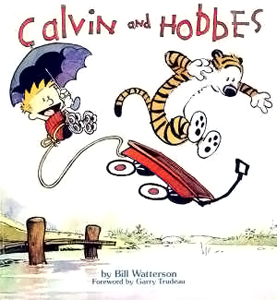
Very few artists ever transcend a medium.
It is not uncommon to push the limits of an art form, by using different color palettes, chords, or words than the norm, but very few people ever break an artistic formula in an attempt to enhance it.
Bill Watterson did not just break the rules of artistic expression; he shattered them, launching his comic strip far beyond the pages of newspapers and into the hearts of a generation.
Calvin and Hobbes isn’t just a comic strip: it’s a treatise on philosophical inquiry, a commentary on human greed, and a magnificent display of Watterson’s own artistic prowess, all told through the adventures of a boy and his tiger.
In a time when the panels of newspaper comics were shrinking and comic strips were being reduced to merely three panel gags, Watterson refused to have his characters forced into smaller panels and instead fought to draw outside of them. Calvin and Hobbes began to take on an otherworldly feeling; Calvin’s boundless imagination, as portrayed through Watterson’s sprawling, colorful landscapes, began to take up whole pages of newspapers, greeting readers each morning with brilliant new worlds.

Calvin and Hobbes Cover
Watterson forced newspapers to comply with his will not through promises of wealth or status; in fact, Watterson refused to merchandise any of his characters, feeling as though his strip’s meaning would be tainted by the free market. Watterson managed to gain more artistic freedom purely through his own merit and the huge following Calvin and Hobbes gathered.
Calvin and Hobbes is, at its base form, the adventures of a mischievous 6-year-old boy and his tiger, and it is because of this simplicity that the story is able to achieve such wondrous heights. Watterson’s characters are not merely interchangeable tools used to set up a gag; instead, both Calvin and Hobbes have their own distinct personalities, complete with thoughts, opinions, and philosophical quandaries reminiscent of their namesakes, philosophers John Calvin and Thomas Hobbes. The strip’s depth lies in its willingness to pose questions worthy of these great minds, yet still simple enough to be asked by a child, albeit a very gifted one.
Calvin and Hobbes, like all great works of art, is timeless in its appeal, being enjoyed not just by people of different generations, but by the same people as they progress through their lives. As children, we’re wowed by Watterson’s colorful imagery and lovable characters; as adults, we’re charmed by Watterson’s insightful humor and ability to ask thought-provoking questions. Each visit to Watterson’s magnum opus leaves the reader with someone new, and inspires everyone to think more deeply about everyday life. Calvin and Hobbes is a beautiful piece of art that will live on for many years to come.

Calvin and Hobbes Final Strip
Works Cited
Watterson, Bill. “About Calvin and Hobbes.” Calvin and Hobbes, 2015, http://www.calvinandhobbes.com/about-calvin-and-hobbes/.
Watterson, Bill. “Calvin and Hobbes Cover.” April 1987.
Watterson, Bill. “Calvin and Hobbes Final Strip.” 31 December 1995.
